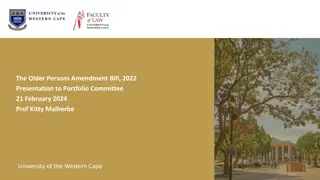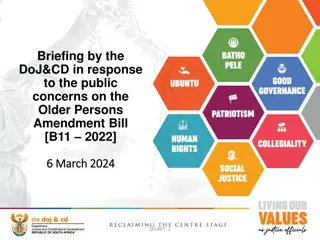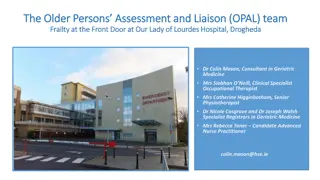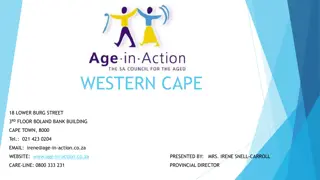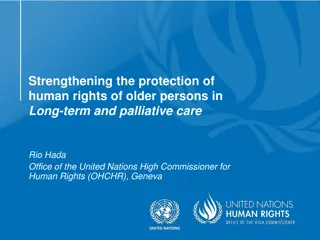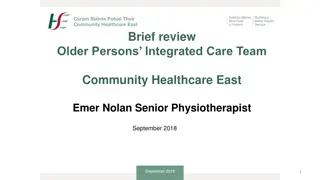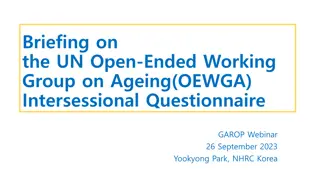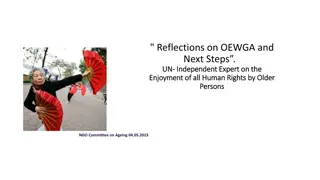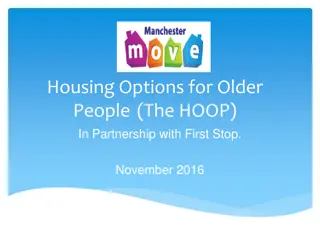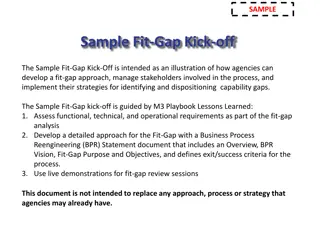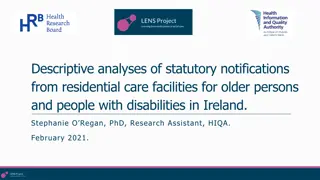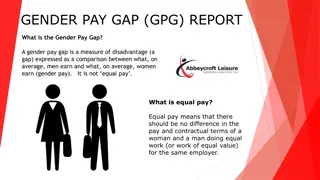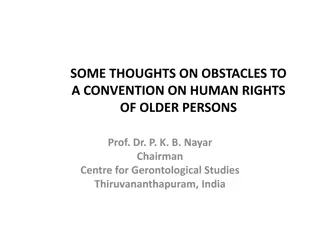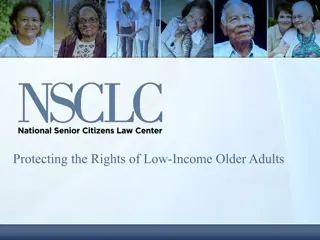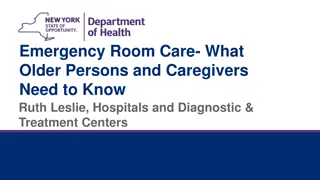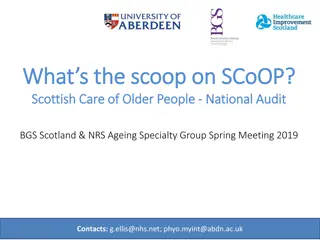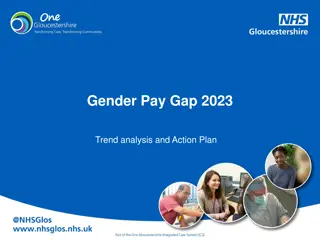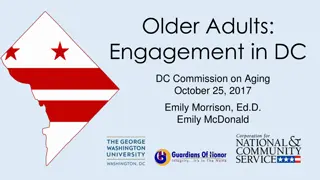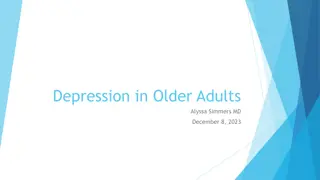Addressing the Justice Gap for Older Persons in Access to Justice
Older persons face a significant justice gap, with millions unable to access civil, administrative, or criminal justice. The absence of dedicated international norms, ageism, and limited UN frameworks contribute to this issue. Barriers include lack of specialist services, digital exclusion, and inadequate legal aid. Addressing these challenges is crucial to protect the human rights of older individuals.
Download Presentation

Please find below an Image/Link to download the presentation.
The content on the website is provided AS IS for your information and personal use only. It may not be sold, licensed, or shared on other websites without obtaining consent from the author. Download presentation by click this link. If you encounter any issues during the download, it is possible that the publisher has removed the file from their server.
E N D
Presentation Transcript
Open-ended Working Group on Ageing for the purpose of strengthening the protection of the human rights of older persons Focus Area: Access to Justice 31 March 2021, Item 6 Bill Mitchell
Overview of the Issues Older persons are in a justice gap The absence of a dedicated international normative instrument significantly limits older persons access to justice UN human rights treaty bodies and thematic special procedures don t address older persons access to justice The UN Principles for Older Persons are limited and aren t binding The COVID-19 pandemic has impacted older person s access to justice at a time when it was critical to their lives
Overview of the Issues The UN development agenda has not assisted: SDG16 lacks specificity for older persons MIPAA only recognises access to justice within a narrow focus Ageism remains a major factor and is a central framing issue for access to justice for older persons Like the UN Principles, age-friendliness is dependent on access to justice No normative obligations means older person s legal needs are not assessed + data is not collected = older persons are invisible
The Justice Gap for Older Persons How big is the justice gap for older persons? 637 Million* older persons face a justice gap: 187 Million cannot access civil, administrative, or criminal justice 562 Million are excluded from the opportunities the law provides Why does this matter? Access to justice is a fundamentally important freestanding right Access to justice protects and promotes other human rights Justice problems negatively impact older persons lives Older persons lack legal identity and suffer further exclusion * Based on World Justice project 2019 data
Barriers to Accessing Justice The justice gap manifests through institutional and personal barriers: Few specialist services, restricted access to legal aid, limited knowledge and information about where to find legal help Greater reliance on family and friends Digital exclusion including social media and law online Limited access to funds The law is disempowering and inaccessible The benefits of engaging with the system are outweighed by the stress, cost and delay Failure to accommodate age-related needs Psychological and emotional barriers
Ageism & the Justice Gap Without normative controls, ageism sits at the center of the justice gap: Ageism is prevalent and more socially accepted than other forms of bias Ageism = institutional, systemic, interpersonal and self-directed ageism Institutional ageism is widespread (in courts, law enforcement, legal assistance, dispute resolution, the legal profession) Systemic ageism affects older persons as direct and indirect participants Self-directed ageism is a common barrier Ageism includes arbitrary age limits
Ageism & the Justice Gap Without normative standards, legal and justice systems are contaminated by ageism: Older persons are seen as having lower compensatory value, less credible witnesses, less able jurors, less needy of legal assistance and a lower priority for law enforcement and protective legal processes and guarantees #Stereotypes The consequences include lost autonomy and independence, violations of rights to family and privacy, free movement, health services, freedom from violence, abuse and institutional neglect #Discrimination Results include low numbers of older complainants and litigants. Legal processes are less commonly commenced and finalized, and older persons have less successful outcomes or simply fail to obtain the opportunities the law provides #Prejudice
Ageism & the Justice Gap Without normative expectations, legal settings and processes entrench ageism: Decision-making and guardianship regimes erode self-determination, privacy, autonomy, independence and dignity Anti-discrimination laws forgive common areas of age discrimination Care facilities confine, control and dehumanize older persons Detention facilities are ill-adjusted to older persons rights and needs Legal and Court processes alienate older persons Criminal laws and prosecutorial conduct ignore, negatively construct or downgrade older persons inherent value or need for protection Again, all manifestations of ageism: stereotypes, prejudice and discrimination, hatred
A Paradox Why don t we have a specific guarantee of access to justice for older persons when: Ageism is more pervasive than sexism and racism (1 in 2 persons) Ageism interacts with other structural inequalities and exacerbates older persons disadvantage Abuse is estimated at 1 in 6 across all settings Age-friendliness is undermined by the absence of justice Almost half of self-represented litigants (pro se) are 50 or older (~45%) Combatting ageism is a principal reason why older persons need access to justice rights, and yet, without a normative standard, structural ageism removes their opportunity to participate in justice on all levels
Intersectionality Older persons need to access justice is heightened by other factors such as gender, indigenous status, race, socio economic status, health, geographic and social isolation, living and care arrangements, incarceration or detention. Despite this increased need, access to justice is more restricted for older persons with these intersecting factors So, for older persons, the greater their need to access justice, the lesser chance it will be attained The forms of injustice that widows are subjected to based on the intersection of their status as a widow, their gender, and often their age are manifold, with some being widespread and others more culturally specific. (WHO, Ageism Report)
COVID-19 The Secretary-General s suggested solution toCOVID-19 s impact on older persons human rights is a strengthened international legal framework. The absence of a clear, enforceable right to access justice means: Ageism, age discrimination, hate speech and stigma will continue unabated as will the impacts of older persons Violence, abuse and neglect will remain hidden without law enforcement and judicial oversight Health care will not be provided on an equal basis Emergency situations mean the right to life is in peril Detention and confinement remains without proper accountability, monitoring or review
The Australian Context Older persons don t have equity of access or recognition: Court Equal Treatment Benchbooks don t include older age Access to formal legal aid systems is poor (~1% of all grants of aid) Older complaints under federal anti-discrimination laws are lowest of all groups (~3% of all complaints) There are no specific criminal laws against elder abuse Half of all long-term care residents experience restrictive practices without effective regulation or redress Specialist programs do make a difference but need normative guidance
The Australian Context Older Indigenous Persons have specific access to justice needs: Factors recognised have included historic, cultural and trauma-related issues including historical abuses such as stolen wages and institutionalization and the impacts of colonization. Their lived experience reflects the intersection of Ageism, racism, ableism compounded by remoteness and linguistic and cultural issues The importance of kinship care models The need to honor and support their role as community elders and leaders of self-determination
The Australian Context Two of Australian peak bodies, Community Legal Centres Australia and the Law Council of Australia have called for drafting to begin on a Convention on the Rights of Older Persons: Older persons human rights should be reflected and articulated in a focused international treaty. They have echoed the Secretary-General s call for a stronger legal framework at the international level, to protect the human rights of older persons both in emergency settings, such as pandemics, and in everyday settings
Community Legal Centres Australia Community Legal Centres Australia is the national peak body for the community legal sector, more than 170 centres across Australia An organization with ECOSOC special consultative status



